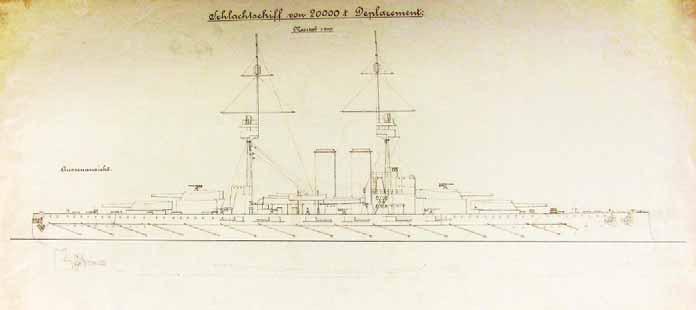this phenomenon had been responsible for the uncontrollable fires on the Russian ships at the Battle of Tsushima when burning coal dust had ignited the flammable paints used by the Russians. These results inspired the Germans to make a study of the flammability of different kind of paints. Gunnery tests on the Meppen test ground also showed that 28 cm APC projectiles fired from 4,000 meters easily penetrated the 300 mm belt armor, the deck armor and the torpedo bulkhead of the Nassau section. As a result, the Germans decided to increase the thickness of the belt armor to 350 mm on their third dreadnought class (Kaiser class).128 The Germans carried out expensive underwater explosion tests from 1906 on test beds which represented full scale battleship and battlecruiser sections. These tests were carried out with the newest 50 cm torpedo warheads which were filled with a 125 kg explosive charge. These tests demonstrated that the armored torpedo bulkheads (30-40 mm thick) near to the side shell plating did not work well; the splinters from the breaking armored bulkhead caused by the explosion pierced the next, thin bulkhead. The Germans concluded that 4-4.5 m was the proper distance between the side shell plating and the armored bulkhead. They also found that the coal stored between the inner plating of the double hull and the torpedo bulkhead successfully absorbed a part of the energy of the explosion. The other important factor of the underwater protection was the minute subdivision of the German dreadnoughts. The Germans subdivided their dreadnoughts with as many watertight compartments as possible and eliminated doors in the watertight bulkheads.129 Koudelka showed to Tirpitz one of the Popper’s design (No. VI), which had ten 30.5 cm guns in five twin turrets, all on the centerline. This was similar to the British Orion). Tirpitz criticized the design’s torpedo protection (torpedo bulkhead was only 2 m from the side shell plating) and pointed to the German test results again. In his opinion such an armament was too heavy for a 20,000 ton battleship. Tirpitz advised to sacrifice a gun turret and increasing the thickness of the belt armor to 300 mm and decreasing the casemate armor to 150 mm. Tirpitz proposed for this design a turret arrangement similar to that of the British battlecruiser Invincible. Before Koudelka left Tirpitz’s office the Admiral called his attention again to the
importance of the torpedo protection and the watertight bulkheads.130 Koudelka handed his top secret report in a sealed envelope on 3 May to Montecuccoli personally.131 However, for unknown reasons it appears that little was done with this information during the final stage of the design of the 20,000 ton battleships to improve the torpedo protection system. Austria-Hungary’s first dreadnoughts were built using Popper’s torpedo protection system of which Koudelka’s report clearly showed that it was flawed in light of German test results. This led to the tragic loss of two of the four battleships. Finalizing the 20,000 Ton Design Two days after Koudelka handed his secret report to Montecuccoli, the STT sent to the Marinesektion a radically new design, designated as No VIII, which had been made at the personal request of Montecuccoli. The new design was armed with twelve 30.5 cm/45 guns in four triple turrets and with ten 15 cm guns in casemates. The thickness of the design’s belt armor was 230 mm and she had two tripod masts.132 This was the first design which resembled the battleships as they were actually built. In the course of the design process of the new battleship, more and more details of the Italian battleship design became known which influenced the Austro-Hungarian plans to a great extent. In December 1908, it had come to the light that the Italian dreadnought was to be armed with twelve 30.5 cm guns, arranged in four triple turrets. The original idea of triple turrets came from Russia: the Russian Navy drew up their specification in December 1907 for battleships which would carry twelve heavy guns in four triple turrets, all on the centerline. The Russians believed that broadside fire was much more important than end on fire, so they prescribed in their specification the “linear” arrangement of the turrets distributed over the length of the ship. The Italian naval constructor, Vittorio Cuniberti was among the fifty-one competitors for the contract, and imported the idea and the arrangement of the turrets. The first Italian dreadnought, the Dante Alighieri, was designed by Edoardo Masdea along the Russian principles, but the Italian ship had a raised forecastle deck.
— 58 —






























